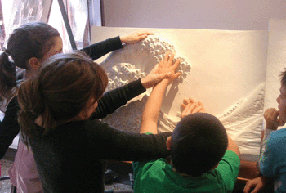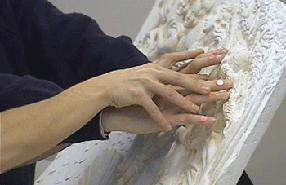There is here the opportunity to verify how the “essential” approach to a work of art is a strength of the “cognitive look” common to the tactile and optical experience, and how it is linked to the courage to abstain from the quantity of information, favouring instead a knowledge of quality. In frequent opportunities of dialog with visitors, we are brought to think about the silence and the eloquence of images, the beauty of the forms bearing a sense and the interiorization of the sense of art, the substance of the aesthetic experience as the sharing of codes of representation and communication of existential content. In many cases it is possible to gather the precious function of discreet listening, the touch of a hand, comparable to the caress of a look: also thanks to that, a reciprocity in the exchange of competence can happen, taking its source in the technical approach to the tactile perception and which outcome leads to the expansion of the tactile sense.
If learning about a work of art also means to connect with ourselves in another way and embrace what goes beyond that, touching with the eyes and seeing with the hands is a concrete act in the theory of art and in the study of the processes of seeing to feel and understand.

The reserved Mantegna and the mystic Caspar David Friedrich were courageous experimenters, lovers of a solitary humanity, not solipsistic, and even for that we have chosen to dedicate ourselves to the study of tridimensional tactile perceptions of the values of shapes, compositions and content of their works. In both experiences, there is space for profound spell and conscious meditation, moving from pleasures and wounds, from the nostalgic sentiment or from the vital strength, from the desire of belonging to the serene detachment: the soul's conditions that every mind contemplates. In concluding this brief presentation of the Anteros Tactile Museum of the Institute for the Blind Francesco Cavazza, we take this opportunity to sincerely thank everyone who, for years, has contributed, with strong commitment, to the growth of this structure allowing it to further its research on tactile perception, hence fostering the school, professional and social integration of people living with vision loss who wish to learn how to develop their skills through aesthetic education.
